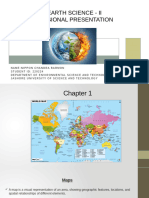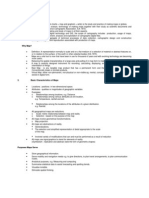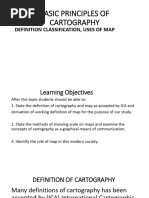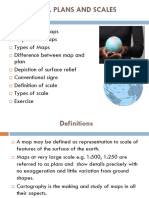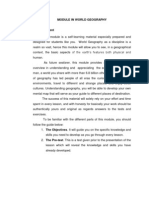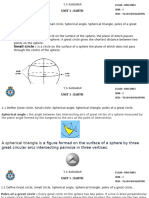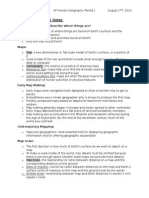Map Compilation
Uploaded by
owenmuriuki526Map Compilation
Uploaded by
owenmuriuki526CARTOGRAPHY REVISION
JM. MUNYAO GEOGRAPHY TEACHER
1. Map Compilation: The process of gathering and integrating various
geographic data sources to create a cohesive and accurate map. This
involves selecting, organizing, and transforming raw data into a
cartographically effective representation.
2. Map Symbolization: The use of symbols, colors, patterns, and other graphic
elements to represent geographical features on a map. This includes
designing standardized symbols to convey information clearly and
effectively to map readers.
3. Form Lines: Lines on a map that represent the shape and configuration of
the land's surface but are not exact measurements of elevation. They are
used to indicate areas of equal elevation or to show terrain features where
precise contour data is not available.
4. Subaqueous Contours: Contours that represent the underwater
topography of bodies of water, such as oceans, lakes, or rivers. These
contours are used to show changes in depth and the shape of the
underwater landscape.
1. Cartography and Special Ways of Presenting Spatial Features on Maps (20
marks)
Cartography, the science and art of map-making, employs various techniques to
present spatial features clearly and meaningfully. The assertion that cartography
has special ways of presenting spatial features can be examined through the
following key points:
Symbolization: Maps use symbols to represent different types of spatial
features, like roads, rivers, cities, and elevations. These symbols are
ways of presenting spatial features
standardized, meaning they are understood universally. Cartographers
choose symbols based on clarity, legibility, and the type of data being
represented.
Scale: A map’s scale determines the level of detail and area covered.
Different scales are used depending on the purpose of the map (e.g., large-
scale maps for detailed features and small-scale maps for broader areas).
Cartographers adjust symbols and representation to fit the chosen scale.
Color and Shading: Color plays a crucial role in maps, providing contrast
and emphasis. For example, water bodies may be represented in blue,
forests in green, and urban areas in gray or beige. Shading techniques like
relief shading help depict three-dimensional terrain on two-dimensional
maps.
Generalization: Cartographers simplify and generalize spatial features on
maps, especially when depicting large areas. They may omit minor details
or merge similar features to avoid cluttering the map.
Coordinate Systems: Maps use geographic or projected coordinate systems
(like latitude/longitude or UTM) to place spatial features accurately on the
Earth’s surface. These systems allow users to pinpoint exact locations.
Topographic and Thematic Representation: Maps can represent
topographic features, such as elevation and landforms, through contours or
spot heights. Thematic maps, on the other hand, focus on specific themes
like population density, climate, or land use, using color gradients or
patterns.
These methods, along with others, ensure that spatial features are represented
accurately, intuitively, and in a way that aligns with the map’s purpose and
audience.
2. Three Types of North Used in Topographic Maps (10 marks)
Topographic maps use various types of "north" to orient and measure spatial
relationships:
True North: The direction that points towards the geographic North Pole. It
is the fixed point of reference for all directional measurements and is
typically indicated by a star on the map.
Magnetic North: The direction towards the magnetic North Pole, which
shifts over time due to changes in the Earth’s magnetic field. A magnetic
compass aligns with this north, but it's important to note that magnetic
declination must be accounted for when converting magnetic north to true
north.
Grid North: The north direction established by the grid system used on the
map (e.g., UTM or a similar projection). It differs slightly from true north
due to the curvature of the Earth. Grid north is crucial for accurate
coordinate-based navigation on maps with a grid system.
3. Techniques Used to Create Thematic Maps (10 marks)
Thematic maps focus on specific themes or phenomena. Cartographers use
various techniques to create them:
Choropleth Mapping: Uses color gradients or patterns to represent the
distribution of a variable (e.g., population density, income levels) across
predefined areas, such as countries, states, or districts.
Dot Distribution Mapping: Dots are used to represent the presence or
quantity of a feature, with each dot corresponding to a specific value. This
technique helps show spatial patterns or concentrations of a phenomenon.
Isoline Mapping: Uses lines (e.g., isobars, isotherms) to represent areas of
equal value of a particular variable (e.g., temperature, air pressure). This
technique is effective in showing continuous data like elevation or climate.
Proportional Symbol Mapping: Symbols (usually circles) are placed on the
map, with their size proportional to the value of the variable they represent
(e.g., population, income). This provides a clear visual representation of
relative quantities.
4. Methods of Mapping Spatial Features on Maps (10 marks)
Mapping spatial features involves several methods to accurately represent the
Earth's surface:
Surveying: Traditional method where cartographers physically measure and
record geographic features on the ground. This can include measuring
distances, elevations, and angles using instruments like theodolites and
GPS.
Remote Sensing: Collecting data from satellites or aerial platforms using
sensors that capture imagery or other data, which is then processed into
maps. This method is useful for large-scale mapping, such as topographic or
environmental changes.
Geographic Information Systems (GIS): GIS integrates spatial data from
multiple sources (surveying, remote sensing, etc.) to create maps. It allows
for advanced analysis and visualization, enabling dynamic mapping and the
layering of various geographic features.
Photogrammetry: Using photographs, particularly aerial or satellite images,
to derive precise measurements of the Earth's surface. This technique
creates detailed topographic maps from stereo imagery.
5. Cylindrical Map Projection (10 marks)
A cylindrical projection involves projecting the Earth's surface onto a cylindrical
surface, which is then unwrapped into a flat plane. It has several characteristics:
Distortion: This projection distorts areas, shapes, and distances, especially
near the poles. The most famous cylindrical projection is the Mercator
projection, which distorts landmasses in higher latitudes, making them
appear larger than they actually are.
Advantages: It preserves direction and is useful for navigation, as lines of
latitude and longitude appear as straight lines and right angles. The
Mercator projection is often used in marine and air navigation charts.
Disadvantages: The distortion of shape and size, particularly at the poles, is
a significant limitation. Greenland and Antarctica, for example, appear
much larger than they are relative to countries near the equator.
Applications: It’s used primarily in navigation and world maps where
maintaining straight lines of direction is more important than accurately
representing area sizes.
6. Visual Variables Used in Cartography (10 marks)
Visual variables are graphical elements used in cartography to distinguish and
interpret features on maps. Key visual variables include:
Size: Varying the size of symbols (e.g., circles or squares) to represent
different quantities or magnitudes. Larger symbols indicate higher values,
while smaller symbols represent lesser values.
Color: Colors can convey information through hue (e.g., different colors for
different categories), value (lightness or darkness), and saturation (intensity
of color). For example, blue might indicate water, while green represents
vegetation.
Shape: Different shapes can symbolize various categories or features. For
instance, squares might represent buildings, while circles could indicate
population centers.
Orientation: The rotation of symbols or lines can convey directional
information or differentiate between different types of features.
Texture: The use of patterns (e.g., stripes, dots) can help to differentiate
between types of features or show relative density.
7. Elements of Base Maps (10 marks)
Base maps serve as the foundation for adding thematic or additional data. Key
elements of base maps include:
Title: A clear title that indicates the map’s purpose or focus, helping the
reader understand what is being represented.
Legend (Key): A guide to the symbols and colors used on the map,
explaining what each represents (e.g., roads, rivers, landmarks).
Scale: A scale bar or ratio that shows the relationship between distances on
the map and the corresponding distances on the Earth’s surface.
Coordinates: The grid system (e.g., latitude and longitude or UTM) that
provides a framework for locating specific points on the map.
North Arrow: Indicates the orientation of the map, helping users
understand which direction is north.
You might also like
- US Navy Course NAVEDTRA 14338 Quartermaster Ed2014100% (1)US Navy Course NAVEDTRA 14338 Quartermaster Ed2014901 pages
- Icse class 8 sms school biology solutionsNo ratings yetIcse class 8 sms school biology solutions44 pages
- 1696314850708_Notes_ICSE_SST(Geography)6_Maps and DiagramsNo ratings yet1696314850708_Notes_ICSE_SST(Geography)6_Maps and Diagrams10 pages
- Social Studies Subject for Middle School - 8th Grade_ Geography and Colonialism XL by SlidesgoNo ratings yetSocial Studies Subject for Middle School - 8th Grade_ Geography and Colonialism XL by Slidesgo22 pages
- UoG Dept of GeES Cartography Lecture NoteNo ratings yetUoG Dept of GeES Cartography Lecture Note95 pages
- Unit-2 Digital Mapping Concepts and Visualization - 1No ratings yetUnit-2 Digital Mapping Concepts and Visualization - 155 pages
- LSRV121-Introduction to Cartography(lecture notes1)No ratings yetLSRV121-Introduction to Cartography(lecture notes1)11 pages
- Geo Informatics Lectures - ConsolidatedNo ratings yetGeo Informatics Lectures - Consolidated58 pages
- NTB Std 7 Representation of Geographical FeaturesNo ratings yetNTB Std 7 Representation of Geographical Features7 pages
- Maps and Cartographic Projections_plus prilohyNo ratings yetMaps and Cartographic Projections_plus prilohy11 pages
- A Presentation On Earth Science 2 SessionalNo ratings yetA Presentation On Earth Science 2 Sessional15 pages
- Chapter 1 Topgraphical Surveying and MappingNo ratings yetChapter 1 Topgraphical Surveying and Mapping11 pages
- FM4-15 Fire Control and Position FindingNo ratings yetFM4-15 Fire Control and Position Finding521 pages
- Ud11t6104-Terrestrial Navigation PPT - 6th Revision - Aug2024 Batch OnwardsNo ratings yetUd11t6104-Terrestrial Navigation PPT - 6th Revision - Aug2024 Batch Onwards70 pages
- Module-94C: Importance of Surveying, Principles and Classification, Mapping Concepts, Coordinate System, Map ProjectionsNo ratings yetModule-94C: Importance of Surveying, Principles and Classification, Mapping Concepts, Coordinate System, Map Projections37 pages
- Working With Grid Coordinates Richard J. Sincovec, LSI0% (1)Working With Grid Coordinates Richard J. Sincovec, LSI26 pages
- ISAT - Coordinate System Defination Dialog BoxNo ratings yetISAT - Coordinate System Defination Dialog Box11 pages
- Geography Skills Handbook Understanding Movement of The EarthNo ratings yetGeography Skills Handbook Understanding Movement of The Earth6 pages
- AP Human Geography Notes Chapter 1 Section 10% (1)AP Human Geography Notes Chapter 1 Section 13 pages
- US Navy Course NAVEDTRA 14338 Quartermaster Ed2014US Navy Course NAVEDTRA 14338 Quartermaster Ed2014
- 1696314850708_Notes_ICSE_SST(Geography)6_Maps and Diagrams1696314850708_Notes_ICSE_SST(Geography)6_Maps and Diagrams
- Social Studies Subject for Middle School - 8th Grade_ Geography and Colonialism XL by SlidesgoSocial Studies Subject for Middle School - 8th Grade_ Geography and Colonialism XL by Slidesgo
- Unit-2 Digital Mapping Concepts and Visualization - 1Unit-2 Digital Mapping Concepts and Visualization - 1
- LSRV121-Introduction to Cartography(lecture notes1)LSRV121-Introduction to Cartography(lecture notes1)
- Ud11t6104-Terrestrial Navigation PPT - 6th Revision - Aug2024 Batch OnwardsUd11t6104-Terrestrial Navigation PPT - 6th Revision - Aug2024 Batch Onwards
- Module-94C: Importance of Surveying, Principles and Classification, Mapping Concepts, Coordinate System, Map ProjectionsModule-94C: Importance of Surveying, Principles and Classification, Mapping Concepts, Coordinate System, Map Projections
- Working With Grid Coordinates Richard J. Sincovec, LSIWorking With Grid Coordinates Richard J. Sincovec, LSI
- Geography Skills Handbook Understanding Movement of The EarthGeography Skills Handbook Understanding Movement of The Earth






